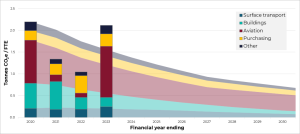Decarbonisation update: the challenge of addressing emissions
Published in May 2024
Everoze partner Benjamin Lock offers an update on our internal decarbonisation work after a challenging year in 2022-23.
Everoze first developed an internal decarbonisation plan in 2019. As an organisation working to accelerate the decarbonisation of the energy sector, we are only too aware that every flight we take, every laptop we buy, and every hotel stay we book as part of this work involves carbon being released into the atmosphere. To address the negative impacts associated with our activities, we have committed to rapidly reducing our emissions while simultaneously investing in accelerated carbon removal schemes to mitigate the effects of the emissions that we cannot avoid.
‘Walking the talk’ on our company mission has been going well so far. We updated our original baselining exercise with a covid-influenced summary in 2021 that revealed significant reductions. We followed that up with a further update in late 2022 that backed up the progress from the year before. But it has not been without its challenges. Updates and improvements to our monitoring process over the last 12 months have significantly delayed the publication of this summary. And more importantly, they have revealed a sharp increase in our emissions for the 22/23 year.
Emissions update
Our full emissions for our 2022/23 financial year are 150.1 tonnes CO2e, or 2.1 tonnes CO2e per full-time equivalent (FTE). The chart shows how this compares to previous years and our original decarbonisation plan. And it doesn’t look great. By far and away the most significant factor is the increase in emissions from flights. There are some caveats here – monitoring improvements mean fewer activities are falling through the gaps, and we have expanded the reporting scope to include some subcontracted work that was previously excluded – but these changes alone cannot account for the increase. Clearly, behaviour has shifted. One major decarbonisation project in this period involved significant travel, but even with the associated emissions excluded, the total figure is far greater than in the recent past. The fact is we are simply flying more than we did in 21/22 and 20/21.
Our collective response
What to do about it? In self-managed organisations like Everoze, the response to challenges of collective behaviour is not to impose restrictions from the top down, but to work together to create structures that enable individuals to make the right decisions for themselves and for the organisation as a whole.
To gauge feelings across the business, we began with a simple survey. The results showed a 95% consensus on taking further action. But there was far less agreement on the best route to take, with some favouring nudges and guidance, and others advocating for something more forceful. We also found strong agreement on the need to balance reducing our emissions with maintaining our ability to deliver our work. This dilemma is one common to many organisations in the environmental sector. If we believe that the work we do is positive, what is an acceptable cost to pay to be able to deliver it?
We worked through exactly this question at length when making our original decarbonisation plan, and the response – that we can massively reduce our impacts without harming our ability to do our work or our bottom line – still holds. This includes things like the obvious preference for train travel over flying where possible, planning our annual all-company get-together in locations most easily accessible for all via low-carbon transport (hello Belgium), and expanding our network of local subcontractors in geographies where we do not have a physical presence.
Yet something has clearly gone awry. Our working hypothesis is that these behaviours are simply no longer front of mind. In response, we will be making some internal changes to get emissions reductions back as part of everyone’s day-to-day. We will also be increasing the frequency of our monitoring reporting, moving towards treating carbon emissions as another metric to be reported on a level with revenue and profit. Watch this space then for updates on how we are getting on.
Making effective mitigations
If there is a silver lining to our increase in emissions, it’s the fact that we will be providing more funding than ever to the two wonderful organisations that will be helping us mitigate the effects of our 22/23 financial year emissions. Specifically, we will be supporting Forest Carbon’s new Cùl Mòr peatland restoration project in the Scottish Highlands and Naturefund’s ongoing afforestation project in the Costa Rican rainforest. As in previous years, we undertook our own carbon sequestration calculations to provide a drawdown over an estimated 10 years instead of the more typical 100-year timeframes. Accounting for tree mortality rates and other factors means we are paying an effective carbon price far greater than that of a typical offset credit – and far more realistic too.
While we are excited to see how Forest Carbon and Naturefund’s works progress and have confidence that it will be effective, mitigation works remain a very small part of the overall picture. Both for Everoze and the wider world, the focus must be on reducing emissions first and foremost. We see our work to enable the renewable energy transition as a vital part of this. And if we can also reduce the harmful side effects of doing that work, then so much the better. But the latest results show the risk of getting complacent, particularly in a self-managed organisation such as Everoze. We also can’t solve these problems alone.
So if you have any insights from working through similar tricky topics with other organisations, we would love to hear from you.




